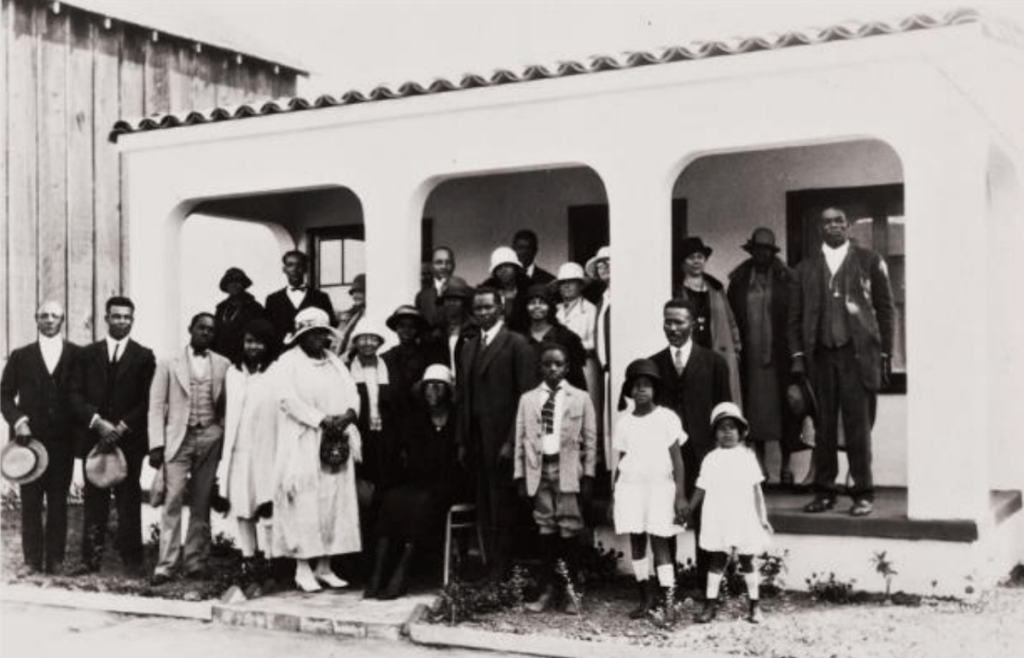Over the Juneteenth weekend, a brand-new look at the history of Black Santa Barbara was released by the city. Focused on the buildings, people, and places that tell that story — from the first visits to Chumash lands in 1542 by Spanish explorers, who subsequently brought with them Black soldiers and also Africans taken by force to the New World, to and through the influx of individuals and families after the turn of the century and World War II — the pages of the draft historic survey are replete with names and images that are readily recognizable and some that are surprisingly shocking.
In the latter category is a photo from 1923 that shows Gutierrez Street rising toward the Riviera, where one hillside has a white cross and the letters “KKK” spelled out beneath it. Santa Barbara, it turns out, was regional headquarters in the 1920s. One form of racism is described as the “redlining” of real estate, a term that came out of the Home Owners Loan Corporation “security risk” maps of color-coded blocks — blue and green for newer white homes, and yellow and red for racially mixed communities. Interestingly, during the Spanish and Mexican colonial days, segregated housing was unknown.
Nicole Hernández, the city’s urban historian, observed that despite the blatant racism of the 1920s — when newspaper ads for housing developments used restrictions as a selling point — “There are so many powerful stories of heroes who improved life for the African-American and Black community.”
One of them was Reverend Henry Benjamin “H.B.” Thomas, the pastor of Mount Olive Baptist Church, more recently known as the Second Baptist Church on East Gutierrez Street. Like many Black leaders in the churches, Thomas supported community social clubs, businesses, and groups like the NAACP and YMCA. He also built an apartment building in 1915, where the parking lot of Staples now exists, at a time when rental housing for Black people was limited.
East Haley Street formed the heart of the Black commercial district, with homes stretching toward the ocean and up to Cota and Anapamu streets. In living memory are places like the Golden Bird Café from the ’60s, on the same block where Black Elks and Muslims had a meeting hall in the Sanchez Building. Just down the road was Otto Hopkins’s Cotton Club, a popular nightclub, particularly notorious for the night then-mayor Edmond O. Hanson got into a fistfight over a lady. Hanson was out of office within a year, but Hopkins lost his liquor license.
Sign up for Indy Today to receive fresh news from Independent.com, in your inbox, every morning.
Hernández — who is from Colorado by way of Georgia’s Savannah College of Art and Design and New Orleans after Hurricane Katrina — recalled designating the San Marcos Building as a landmark for the city in 2015. “It was really exciting to learn that Dr. Frances E. Ford, a Black woman and practicing podiatrist, had an office in the San Marcos Building,” she said. “It was such a huge accomplishment in the 1920s.”
These tales just scratch the surface of a fascinating history assembled in record time. Work started on November 1, 2021, and the final write-up is due September 30, 2022, per the terms of the grants. The team working alongside Hernández included Flora Chou of Page & Turnbull, which had experience in similar projects in San Francisco and Los Angeles. Members of Healing Justice Santa Barbara — Krystle Farmer Sieghart, Simone Akila Ruskamp, and Leticia Forney Resch — combed through records held in area libraries, the Black-owned newspaper the California Eagle, and interviews with E. Onja Brown, Isaac Garrett, Akivah Northern, and Greg Freeland. Sojourner Kincaid Rolle also opened her collection of historic documents and lent her particular knowledge of the subject.
In the run-up to September, Chou and Healing Justice intern Kylah Jordan anchored a booth at Sunday’s Juneteenth celebration, talking with residents about the project and passing out postcards and stickers asking them to share photos and information with Healing Justice S.B. Around 3,000 people attended Juneteenth, said organizer Jordan Killebrew.
About $66,000 in funding for the project came through grants from the California Office of Historic Preservation and the City of Santa Barbara. Asked what’s next, Hernández said part of her job was to designate historic structures, so she’d be looking at a few possibilities. Then it might be grant-writing time again for further research.
Correction: Dr. Frances E. Ford’s first name has been corrected to be spelled with an “e.”
Support the Santa Barbara Independent through a long-term or a single contribution.

